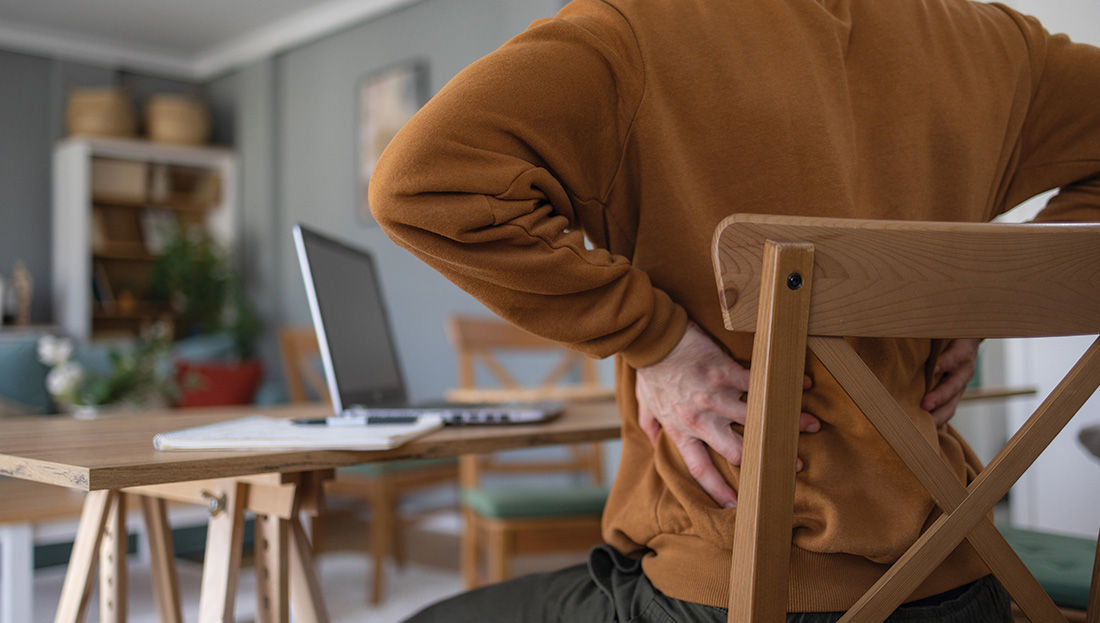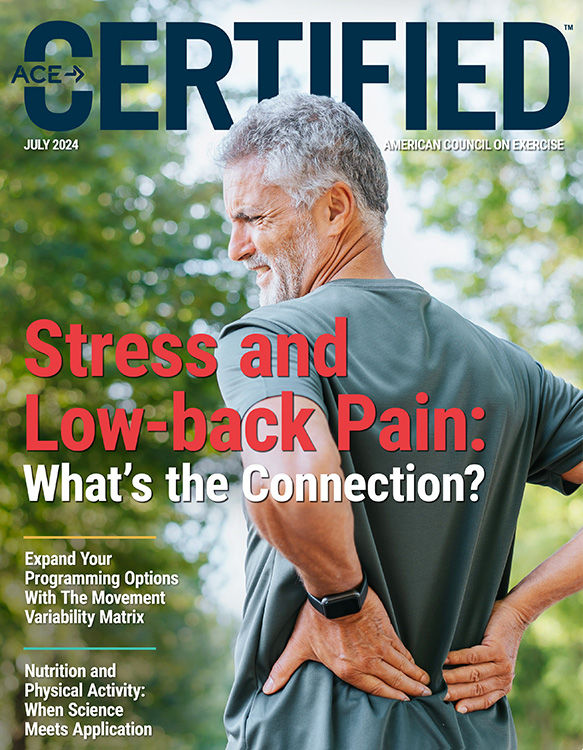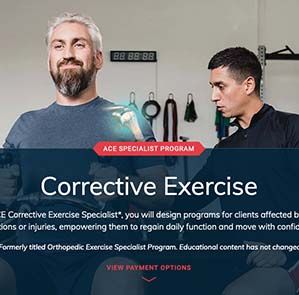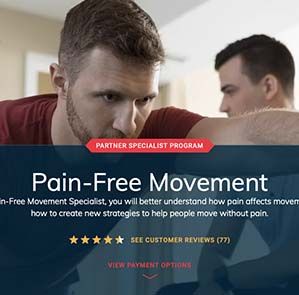
If a client were to come to you complaining of low-back pain, what would your initial response be? You might talk about posture and incorporate more core training into their workouts. You might encourage them to sit less and move more throughout their workday. Or, you might refer them to their doctor or a massage therapist.
But would you think to ask them about their stress levels or their emotional state? Probably not, at least not at first.
The Mayo Clinic lists five conditions commonly linked to back pain: muscle strain or ligament sprain, bulging or ruptured disks, arthritis, osteoporosis and ankylosing spondylitis. And, while one or more of those conditions may be at play (though it’s certainly not your job to diagnose any of those conditions), it’s also possible that your client has been feeling the pinch of financial strain, going through a busy time at work or having issues with their partner or children. So, perhaps that’s the best place to start—with a conversation about managing stress.
The message here is not meant to downplay the physiological or biomechanical issues that can cause back pain, which are very real and can lead to debilitating levels of discomfort, but instead to highlight the mind-body connection and the need to add stress-management techniques to your toolbox when working with clients with low-back pain.
Individualized Responses
According to Dr. Stuart McGill, Chief Science Officer for BackFitPro and distinguished professor emeritus at the University of Waterloo, “With every individual, and every condition of every individual, there are several phenotypes. What I mean by that is, people respond differently to the same training program, for example. We all respond differently to virtually everything.”
And, he says, “There are phenotypes in how people handle stress.”
Dr. McGill points us to a study that mimicked a manufacturing facility in order to evaluate how different personality types responded to a stressful situation. Before the study, all participants underwent a personality inventory that classified them into two categories, the first being a more timid and accepting personality and the other being a take-charge, outgoing personality. Then, as the participants worked in the pseudo-manufacturing facility, without warning a “boss” would begin yelling at them about their performance.
What the researchers found is that for the more timid folks, there was a visceral, physiological response to stress, as they tensed their muscles and constricted their joints. The other group did not display this type of response.
The lesson here is not to encourage your clients to alter their personalities, but rather to help them recognize their own tendencies and work to counter them through specific exercises and stress-management techniques. If they find that their stress often manifests as tension or pain, introducing techniques to manage that stress may be very beneficial.
The Cycle of Stress and Pain
There is no doubt that our mental states—specifically our stress levels—show up physiologically. That may be in the form of sweaty palms before an important presentation, an increased heart rate during an argument, or shallow and quick breathing when serious anxiety kicks in.
People will often say that they “carry their stress” in a particular part of the body, such as the shoulders, neck or lower back. But what exactly does that mean? Likely, they alter their posture or contract their muscles when under pressure or feeling stressed, which causes muscle tightness, altered joint positions and restricted blood flow in that area of the body.
For example, a client who works at a computer all day may lean forward and shrug their shoulders when highly focused on a stressful task (such as writing an article about stress and low-back pain while under a strict deadline, but that’s just a hypothetical). Later on, that may lead to shoulder pain or a stiff neck, which the person attributes to “carrying their stress” in their shoulders rather than to a behavior they may be able to alter in order to break the stress–pain cycle.
That cycle can be self-perpetuating. When someone is in pain, no matter the cause or location, it will typically affect them emotionally and mentally. They may be upset that they can no longer take part in activities they enjoy, or they may feel less focused, more anxious or depressed, or even angry. Those stress-related feelings will make them less likely to be physically active, which leads us back to where we started, with stiffness and pain. Pain causes stress which causes pain and so on.
The key is to interrupt that cycle one way or another.
Fortunately, the cycle can also run with a more positive spin, such that a person who successfully uses stress-management techniques to reduce their stress levels may find themselves more able to be physically active, which will make them less prone to stress-related pain in the future. Reduced stress causes pain relief, which reduces stress and so on.
How to Address Both Sides of the Pain-stress Equation
As a health coach or exercise professional, the ultimate goal is to address both sides of the pain–stress equation by incorporating exercises to address low-back pain (or better yet, prevent it from occurring in the first place) while also implementing stress-management techniques that the client can use in their daily life.
According Reena Vokoun, Founder and CEO of Passion Fit and an ACE Certified Health Coach and Group Fitness Instructor, “They go hand in hand.” When acting as a health coach, Vokoun says she will often discuss the connection between stress and pain as part of her holistic approach to wellness. “We always talk about what’s going on physically, mentally and emotionally,” she says, “and how all of those things connect.”
Speaking about her work as a group fitness instructor—Vokoun teaches a variety of classes five days a week, including yoga, Pilates, barre, boot camp, dance and high-intensity interval training (HIIT)—she says, “At the end of every one of my sessions, I have a mindfulness section. Before we get into the cool-down and stretch, we do something almost like a savasana pose in yoga, where I have everyone lie down on their mats, close their eyes, [and] start to tune into their breath; and we’ll even do a body scan.”
She uses this time to talk the class through how they worked their muscles that day and ask them to visually picture themselves releasing that tension, feel their heart rate and breath slowing down, focus on the present moment and tune into how the mind and body work together.
Interestingly, Vokoun includes these mindfulness moments in even her most physically demanding HIIT and boot camp classes, and participants routinely welcome and appreciate the moment of reflection and how she takes a holistic approach to wellness by combining the physical with the mental and emotional.
Shake it off
Dr. McGill offers an easy way to feel how stress can cause pain over time.
People under stress tend to clench their glutes and lock out their knees when standing, he explains. To feel the impact of that altered posture, stand with what Dr. McGill calls “a column of stacked masses”: ears over shoulders, shoulders over hips, hips over knees. Now, place a hand on the erector spinae muscles in the lower back while standing with good posture, then clench the glutes and lock your knees. You should feel those lower-back muscles tighten in response.
Now, imagine how that tension might cause pain over time due to chronic stress. According to Dr. McGill, “If a person who holds a muscle in chronic contracture, because of stress or fear or anxiety, the muscle will ache.”
If you have clients who recognize this stress response, encourage them to periodically shake out their knees and become aware of that hard-locked knee extension so that they respond accordingly when they feel the stress building.
If you’re interested in learning more about alleviating back pain, check out Dr. McGill’s book Back Mechanic: The Step-by-Step McGill Method to Fix Back Pain.
Let’s take a look at some stress-management techniques and then review a few different approaches to exercise programming that you might want to consider.
Stress-management Techniques
For Vokoun, the most impactful stress-management technique is diaphragmatic breathing. “When we breathe with the chest,” she explains, “that’s when people start to hyperventilate. So, I tell them to breathe deep into the diaphragm, into the belly.” Breathing in through the nose and out through the mouth and slowly contracting and pulling the belly back in on the exhale calms the mind and body, slows the heart rate, and changes the depth and rate of respiration.
Vokoun enhances this breathing technique by providing cues that help clients connect the physical and emotional sides of health. For example, she might say, “inhale positive energy and exhale the negative” to paint a picture where they see themselves relieving stress.
You might also personalize the cueing if you know what a client or class participant is struggling with, such as, “inhale courage and exhale fear” or “inhale healing and exhale pain.”
Here are some additional effective stress-management techniques to share with your clients:
Get outside and move. Green exercise—that is, movement that takes place in a natural setting—yields benefits beyond those seen with exercise alone. It also gives you time away from screens to breathe fresh air, feel the breeze, move the body and reconnect with yourself. And, it doesn’t have to be a long or strenuous workout to be effective. A 10-minute walk is enough to improve mood and enhance mental well-being.
Keep a journal. This is another of Vokoun’s favorite techniques, especially for clients who find their sleep is being negatively impacted by stress. “Taking whatever is ruminating in your mind that’s making you feel stressed, keeping you up at night, or creating physical symptoms of pain in the body, and simply writing them out can be very cathartic,” she explains. Seeing something written out on paper can provide a new perspective, in that you can observe your thoughts as a third party. It might give you ideas for problem solving or at least let you feel like you “got it out.”
Create a playlist. Music can create a specific feeling or mood, so the first step is to determine what type of stress you’re feeling. Is it a situation where you want to calm yourself down, or do you have an anxious stress where you want to get out your energy? If it’s the former, create a playlist of calming music that allows you to relax, breathe deeply and slow your heart rate. If it’s the latter, create a playlist that gets you hyped up to exercise and work out that nervous energy.
Set—and maintain—boundaries. If certain behaviors or routines provide stress relief, set them as unbreakable calendar events. This might include gym time, morning meditation or a 30-minute lunchtime walk. The point is to avoid allowing other responsibilities to overwhelm you and take over the time you have set aside for yourself.
Exercises for Low-back Health
As with all exercise programming, an exercise routine for low-back health should be personalized and based on each client’s goals, fitness level and type/degree of pain. The examples provided here are exactly that—examples.
As you collaborate with your clients to develop personalized programming, consider the following steps when selecting exercises to improve low-back function:
- Address any imbalance between the right and left sides.
- Address any anterior/posterior postural imbalances (e.g., pelvic tilt).
- Increase functional internal and external rotation of the hip.
- Strengthen the posterior chain, especially the hamstrings and gluteal muscles.
One focus should be on muscular endurance, which has a protective effect on the postural muscles of the low-back. The following routine for low-back health, which can be performed daily, is based on insights from Dr. McGill’s book Low Back Disorders: Evidence-Based Prevention and Rehabilitation (you can find video demonstrations of the last three exercises here).
- Cat-Cow
- Modified Curl-up (also called the McGill Curl-up)
- Bird Dog
- Side Bridge (also called a Side Plank)
Dr. McGill recommends adding low-back and core strength to this endurance/mobility routine. You can use the ACE Exercise Library to explore your options, but here are a few examples of beginner-level exercises that might be suitable for clients with low-back pain:
Finally, Lauren Shroyer, MS, ATC, ACE Vice President of Product and Innovation, who teaches a continuing education course entitled Chronic Back Pain: Training the Hips and Feet for Improved Results, reminds us that low-back pain often originates further down the kinetic chain. Here, she offers some advice and exercise examples.
“When there is a kinetic chain imbalance,” she explains, “it is crucial to identify the root cause and use static stretching to achieve a lasting change in muscle length, followed by strengthening exercises to reinforce the new length by building sarcomeres and strengthening cross-bridges.”
For example, it is not uncommon for the kinetic chain be disrupted at the knee or foot due to a previous injury. When this occurs on only one side, you may observe that one hip is lower than the other. In this case, pain can be experienced on either side of the low back. To support ease of movement and decrease pain, look to the foot and knee.
If the knee is in a valgus position (knock-kneed), then the iliotibial band (ITB) and tensor fascia latae (TFL) muscles are probably tight. This is usually accompanied by a tight hip flexor group and subsequent lengthened position of the glutes and external rotators of the hip and hamstrings.
The following exercises can and should be done on both sides. However, if the valgus knee position is on only one side, they should be done on only that side. Remember, the goal is to restore balance.
Foam Rolling and Stretching
Foam rolling the ITB and TFL is a great way to start the workout. Continue foam rolling for 1 to 3 minutes but keep in mind that a client may have to work up to that length of time.
Strengthening
- Single-leg Romanian Deadlift – If balance is an issue, use a wall or doorframe for balance. Keep the hips parallel with the floor.
- Front Squat – Use light weights (or begin with body weight only) to avoid overactivating the low-back muscles. To help your client maintain good form, it can be helpful to place a box or bench behind them so they are hinging back from the hip and encouraging greater engagement from the glutes.
When working with a particular client, you may opt to use some or all of these approaches but be sure to align the exercises with the client’s goals and physical abilities to avoid exacerbating any existing pain.
Final Thoughts: Take a Holistic Approach
Reena Vokoun reminds us of the interconnectedness of the various pillars of health and how a holistic approach to wellness is a vital part of breaking the stress–pain cycle. This includes not only physical activity and stress management, but also sleep, nutrition and hydration.
Stress can keep us up at night, negatively impacting both the quality and quantity of sleep, which, in turn, can cause more stress and leave us too fatigued to exercise at full capacity.
Cravings for unhealthy, high-sugar, high-fat snacks often occur when we’re stressed and overtired, and eating those foods can make us feel worse. We get a sugar high, then crash. Sodium causes bloating. Fast food can lead to feelings of guilt or regret, which can then worsen stress levels. And dehydration can cause headaches. In combination, unhealthy food choices can leave us feeling sluggish and down emotionally.
“If you can put nourishing, nutrient-dense foods in your body,” Vokoun explains, “especially when you’re feeling stressed, then that’s going to help you feel better and function better, and you’re going to feel replenished and nourished so that you can have the energy to think more clearly and come out of that stressful state.”
Put this all together and it becomes clear that when a client complains of low-back pain, there are a number of questions that should be asked and approaches that should be considered. Thinking more holistically about health and well-being can help you empower your clients to make behavioral changes that may impact every aspect of their lives.
Expand Your Knowledge
ACE Corrective Exercise Specialist Program
Injuries and chronic conditions can have a devastating impact on an individual's lifestyle. As an ACE Corrective Exercise Specialist, you will help clients regain function and return to normal movement. You will coach clients to improved function, mobility, stability and strength, which will lead to less pain, better health and increased all-around quality of life. You will be equipped to work with a wide variety of clients, from those who want to jump back into an exercise regimen quickly to those who are afraid of moving and reinjuring themselves.
ACE Pain-free Movement Specialist Program
The Pain-Free Movement Specialist program was built upon the Function First Approach—which believes that eliminating pain is best achieved by addressing the body as a whole, and that pain is unique to each individual. As the only exercise-based program designed specifically using a biopyschosocial approach, you will learn how pain affects the balance of your clients’ physical biology, social interaction, and psychological state, and then how to coach exercise sequencing in a given session based on their biological, psychological and emotional readiness. As a Pain-Free Movement Specialist, you’ll help clients overcome the pain that has damaged their lives—in some cases—for years.
Chronic Back Pain: Training the Hips and Feet for Improved Results
This course offers a transformative approach to combat chronic back pain, covering exercise selection, progression and regression for ideal program design. You will also explore essential strategies to provide pain relief and restore vitality in your clients with exercises that are ideal for clients with knee pain. Whether you're a personal trainer or group fitness instructor, this course will equip you with the knowledge to make a profound difference in the lives of those suffering from low back and knee pain.





 by
by 





